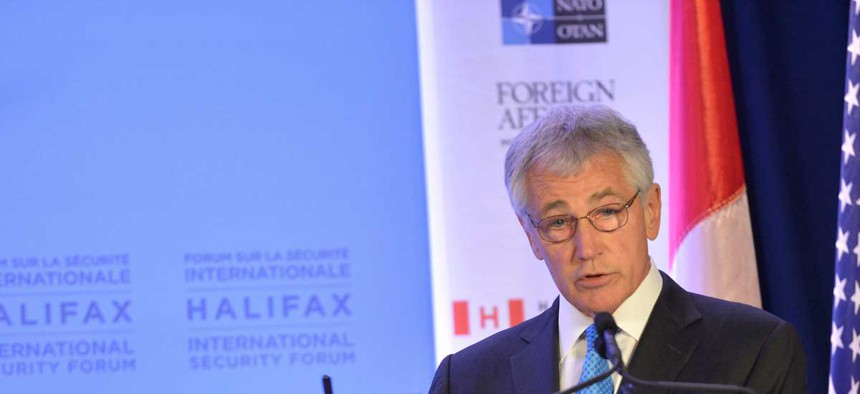
Defense Secretary Chuck Hagel speaking at the International Security Forum in Halifax, Nova Scotia, Canada. DOD photo by Glenn Fawcett
Pentagon Outlines Stronger Military Presence in the Arctic
Defense Secretary Chuck Hagel said the Pentagon’s new Arctic Strategy will significantly increase U.S. military resources and attention to the polar region. By Kevin Baron
HALIFAX, Nova Scotia -- Citing American interests in climate change, energy security and the integrity of northern sea lanes, Defense Secretary Chuck Hagel introduced a new Pentagon plan for Arctic security on Friday that promises to significantly increase U.S. military resources and attention to the polar region.
The plan is the Defense Department’s follow-on to President Barack Obama’s national Arctic strategy, released in May. The Arctic has gained increased attention in security circles as melting ice caps promise new access to strategic positions and undersea resources for three of the worlds most powerful countries in the U.S., Russia, and China, as well as Canada and NATO.
“In order to realize the full potential of the Arctic, nations must collaborate and build trust and confidence through transparency and engagement,” Hagel said at the Halifax International Security Forum in Canada.
(Related: To Reach the East, NATO Must First Go North)
The U.S. will not relent in defending Alaska and its northern borders, Hagel said, laying out an 8-point plan to 1) Protect U.S. borders and Alaska, 2) do more to more study the environment, 3) enforce the law of the seas, 4) “evolve” Defense Department capabilities and infrastructure, 5) increase international training, 6) prepare for natural disasters, 7) protect the Arctic environment, and 8) build and enforce international institutions and organizations.
“We are beginning to think about and plan for how our Naval fleet and other capabilities and assets will need to adapt to the evolving shifts and requirements in the region,” Hagel told the audience of international officials, including a congressional delegation led by Sen. John McCain, R-Ariz.
Hagel is scheduled to return to Washington on Friday evening. The forum continues through Sunday.





